Complete Solutions to Ordinary Thinking Objective Questions (Electric Field and Potential) of chapter ELECTROSTATICS of Class 12 book with complete answers and questions
| Class 12 | PHYSICS |
| Chapter | ELECTROSTATICS |
| ERRORLESS | Ordinary Thinking Objective Questions (Electric Field and Potential) |
| Number Of Questions | 100 |
| Academic Year | 2023-24 |
A charge q is placed at the centre of the line joining two equal charges Q. The system of the three charges will be in equilibrium if q is equal to:
03:43View SolutionInside a hollow charged spherical conductor, the potential
01:06View SolutionTwo small spheres, each carrying a charge q are placed r m apart and they interact with force F. If one of the sphere is taken around the other once in a circular path, the work done will be equal to
02:28View SolutionAn electric charge in uniform motion produces
01:20View SolutionTwo charged spheres of radii 10 cm and 15 cm are connected by a thin wire. Current will flow through them if they have the same
1. charge on each
2. energy
3. potential
Which of the statements given above is/are correct ?06:29View SolutionThe electric field inside a spherical shell of uniform surface charge density is
02:28View SolutionThe electric potential V at any point x,y,z (all in metre) in space is given by `V=4x^2` volt. The electric field at the point `(1m, 0, 2m)` is ……………`V/m`.
01:39View SolutionA hollow metal sphere of radius `5 cm` is charged so that the potential on its surface is `10 V`. The potential at the centre of the sphere is
01:21View SolutionIf a unit positive charge is taken from one point to another over an equipotential surface ,then
01:29View SolutionElectric lines of force about negative point charge are
01:34View SolutionCharges of `+(10)/(3) xx 10^(-9) C` are placed at each of the four corners of a square of side `8 cm`. The potential at the intersection of the diagonals is
02:46View SolutionA uniform electric field having a magnitude `E_(0)` and direction along the positive X-axis exists. If the potential `V` is zero at `x = 0`, then its value at `X = +x` will be
01:19View SolutionThree charges `2q, -q, and -q` are located at the vertices of an equilateral triangle. At the center of the triangle,
06:30View SolutionFigure shows the electric lines of force emerging from a charged body. If the electric field at`A` and `B` are `E_(A)` and `E_(B)` respectively and if the displacement between `A` and `B` is `r` then
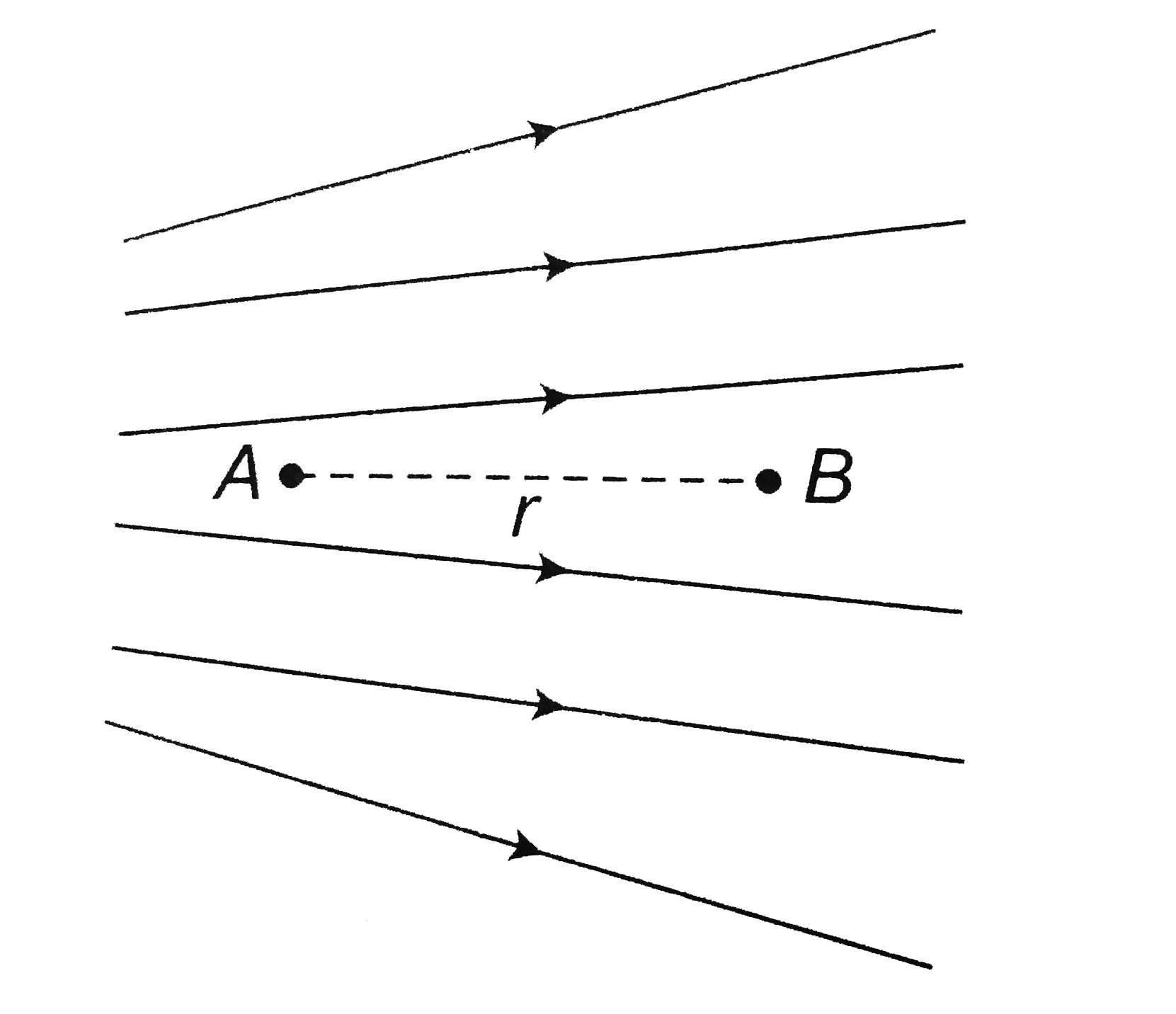 04:31View Solution
04:31View Solution`ABC` is an equilateral triangle. Charges `+q` are placed at each corner. The electric intensity at `O` will be
 02:00View Solution
02:00View SolutionIn the electric field of a point chargde `q`, a cetrain charge is carried from point `A` to `B, C, D` and `E`. Then the ork done
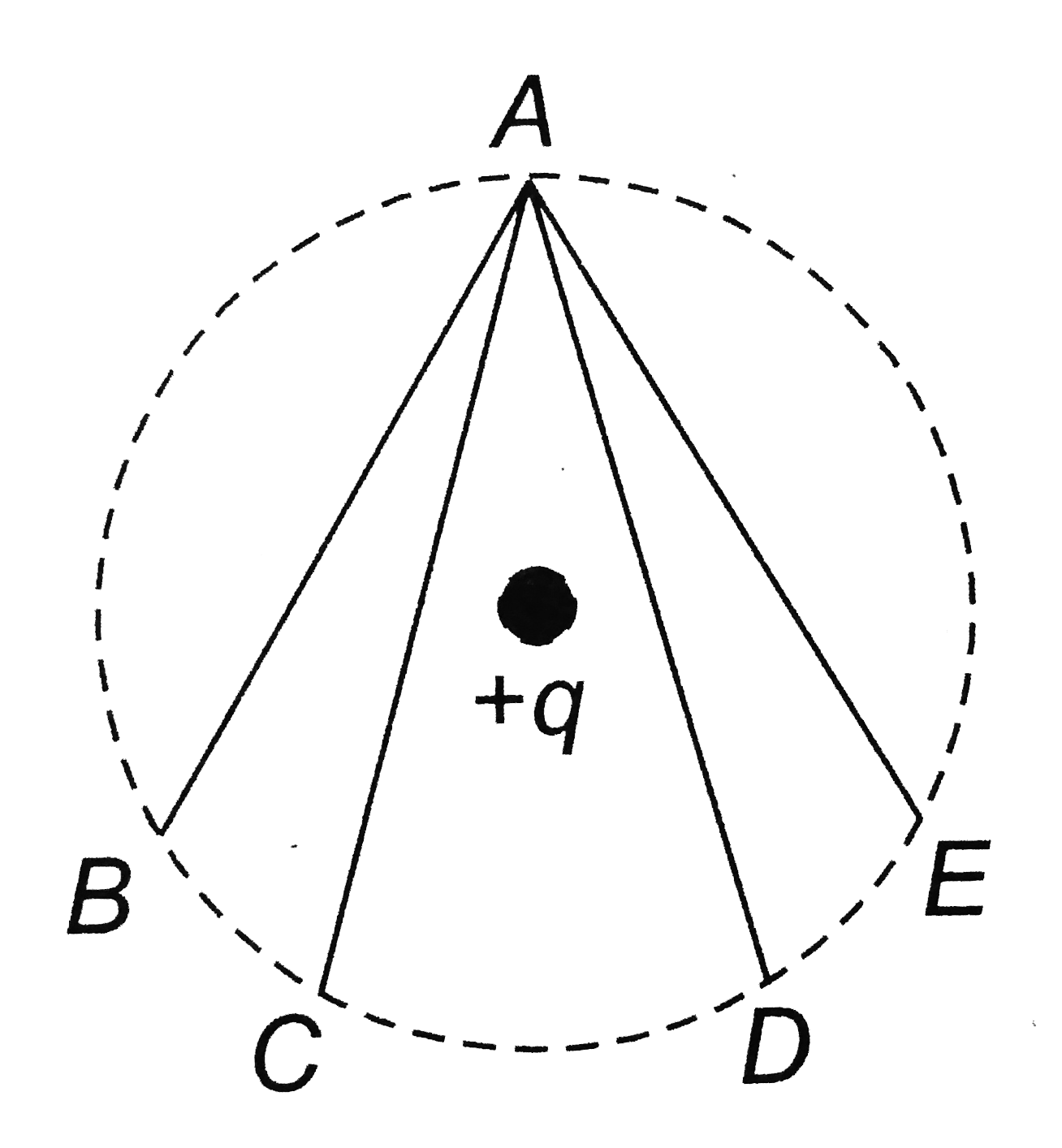 02:09View Solution
02:09View SolutionThe magnitude of electric field intensity E is such that, an electron placed in it would experience an electrical force equal to its weight is given by
01:13View SolutionA conductor with a positive charge
03:01View SolutionAn electron and a proton are in uniform electic field. The ratio of their acceleration will be
04:07View SolutionTwo parallel plates have equal and opposite charge. When the space between them is evacuated, the electric field between the plates is `2xx 10^(5)` V/m. When the space is filled with dielectric, the electric field becemes `1xx10^(5)` V/m. The dielectric constant of the dielectric material is
01:41View SolutionThe insulation property of air breaks down at `E=3xx10^(6) "volt"//meter`. The maximum charge that can be given to a sphere of diameter `5m` is approximately (in coulombs)
02:54View SolutionThe distance between the two charges `25 mu C` and `36 muC` is `11 cm`. At what point on the line joining the two, the intensity will be zero
04:08View SolutionTwo spheres A and B of radius 4 cm and 6 cm are given charges of `80 muC and 40 muC`, respectively. If they are connected by a fine wire, then the amount of charge flowing from one to the other is
05:51View SolutionA charge particle is free to move in an electric field. It will travel
03:14View SolutionIf `E` is the electric field intensity of an electrostatic field, then the electrostatic energy density is proportional to
01:05View SolutionA metallic sphere has a charge of `10 mu C`. A unit negative charge is brought from `A` to `B` both `100 cm` away from the sphere but `A` being east of it while `B` being on west. The net work done is
02:11View SolutionTwo charges `+4e` and `+e` are at a distance `x` apart. At what distance,a charge `q` must be placed from charge `+e` so that is in equilibrium
02:49View SolutionAn uncharged sphere of metal is placed in between two charged plates as shown. The lines of force look like
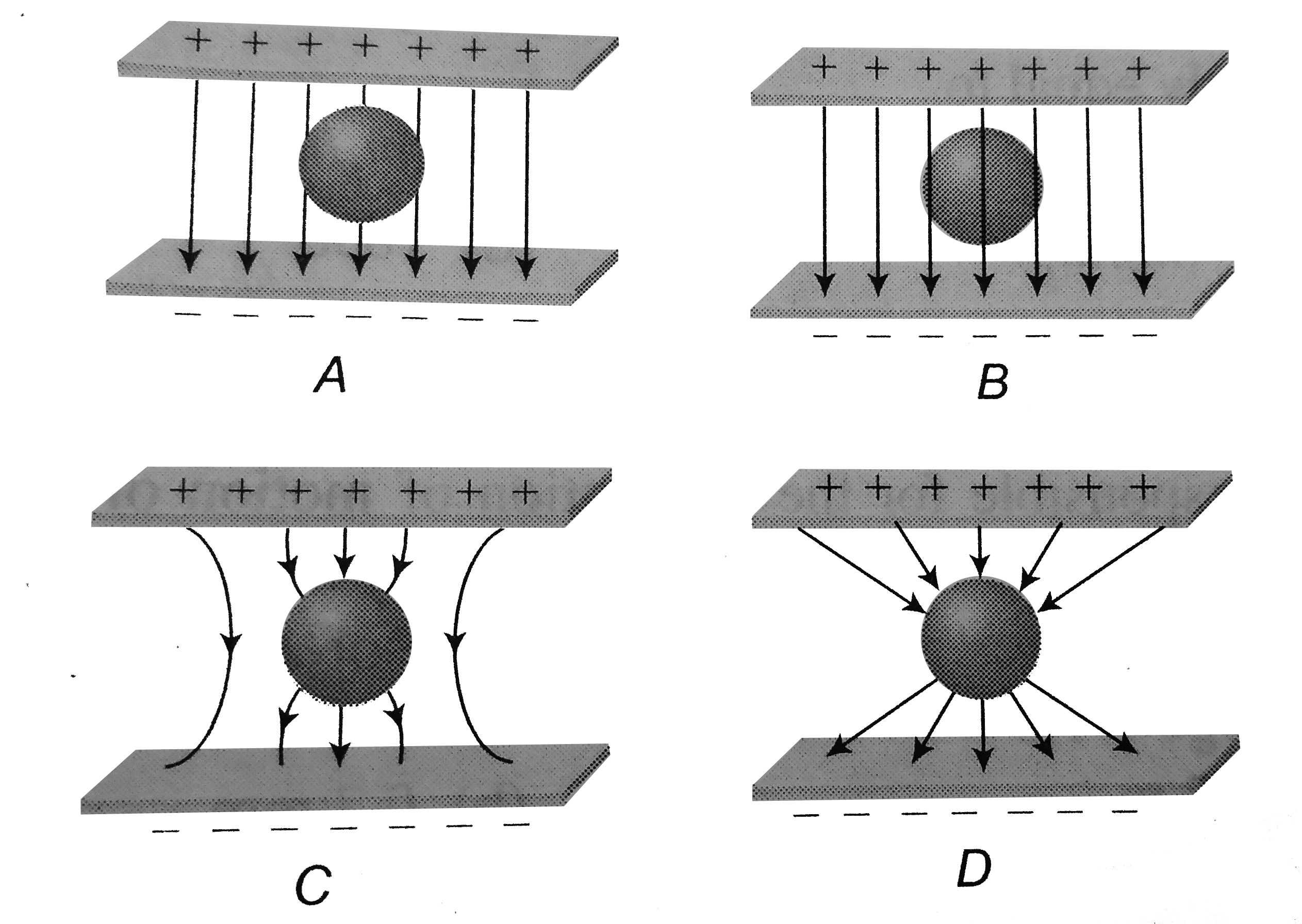 04:03View Solution
04:03View SolutionThe intensity of electric field required to balance a proton of mass `1.7xx10^(-27)kg` and chrage `1.6 xx 10^(-19) C` is nearly
02:35View SolutionOn ortating a point charge having a charge `q` around a chrage `Q` in a circla of radius `r`. The work done will be
01:37View SolutionTwo point charges `Q` and `-3Q` are placed at some distance apart. If the electric field at the location of `Q` is `E` then at the locality of `-3Q`, it is
02:13View SolutionThe number of electrons to be put on a spherical conductor of radius `0.1m` to produce an electric field of `0.036N//C` just above its surface is
02:23View SolutionTwo plates are `2cm` apart, a potential difference of `10` volt is applied between them, the electric field between the plates is
01:21View SolutionThe intensity of the electric field required to keep a water drop of radius `10^(-5) cm` just suspended in air when charged with one electron is approximately
03:46View SolutionConduction electrons are almost uniformly distributed within a conducting plate. When placed in an electric field `vec(E )`, the electric field within the plate
02:16View SolutionThree particles, each having a charge of `10 mu C` are placed at the coners of an equilateral triangle of side `10 cm`. The electrostatic potential energy of the system is (Given `(1)/(4pi epsilon_(0)) = 9 xx 10^(9)N-m^(2)//C^(2))`
02:06View SolutionThe electric field near a conducting surface having a uniform surface charge density `sigma` is given by
03:08View SolutionThere is an electric field E in x-direction. If the work done on moving a charge of `0.2C` through a distance of 2w m along a line making a angle `60^@` with x-axis is 4 J, then what is the value of E?
01:29View SolutionFour equal charges `Q` are placed at the four corners of a square of each side is 'a'. Work done in removing a charge `-Q` from its centre to infinity is
03:49View SolutionA particle `A` has chrage `+q` and a particle `B` has charge `+4q` with each of them having the same mass `m`. When allowed to fall from rest through the same electric potential difference, the ratio of their speed `(v_(A))/(v_(B))` will become
02:09View SolutionDeutron and `allpha`- particle are put 1Å apart in air. Magnitude of intensity of electric field due to deutron at `alpha-`particle is
02:07View SolutionAngle between equipotential surface and lines of force is
03:07View SolutionBelow figures (1) and (2) represent lines of force. Which is correct statement
 03:11View Solution
03:11View SolutionThe unit of electric field is not equivalent to
02:08View SolutionA flat circular fixed disc has charge +Q uniformly distributed on the disc. A charge +q is thrown with kinetic energy K, towards the disc along its axis. The charge q :
05:17View SolutionAt a certain distance from a point charge, the electric field is 500 V/m and the potential is 3000 V. What is the distance ?
01:54View SolutionThe magnitude of electric field `vecE` in the annular region of a charged cylindrical capacitor.
04:05View SolutionA metallic solid sphere is placed in a uniform electric fied. The lines of force follow the path(s) shown in Figure as
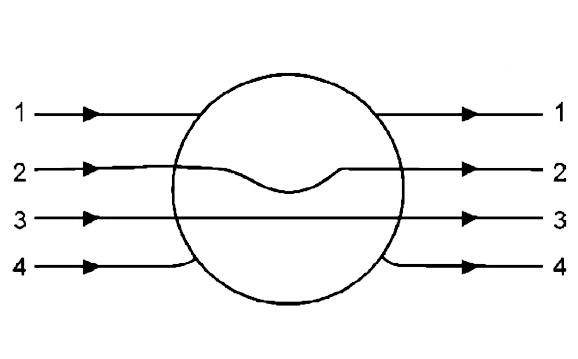 02:17View Solution
02:17View SolutionThe distance between a proton and electron both having a charge `1.6xx10^(-19)` coulomb, of a hydrogen atom is `10^(-10)` metre . The value of intensity of electric field produced on electron due to proton will be
02:00View SolutionWhat is the magnitude of a point charge due to which the electric field `30cm` away the magnitude `2`?
`[1//4 pi epsilon_(0)=9xx10^(9)Nm^(2)//C^(2)]`02:06View Solutiontwo charge `+q` and `-q` are situated at a certain distance. At the point exactly midway between them
02:10View SolutionIn the firgure the charge `Q` is at the centre of the circle. Work done is maximum when another charge is taken from point `P` to
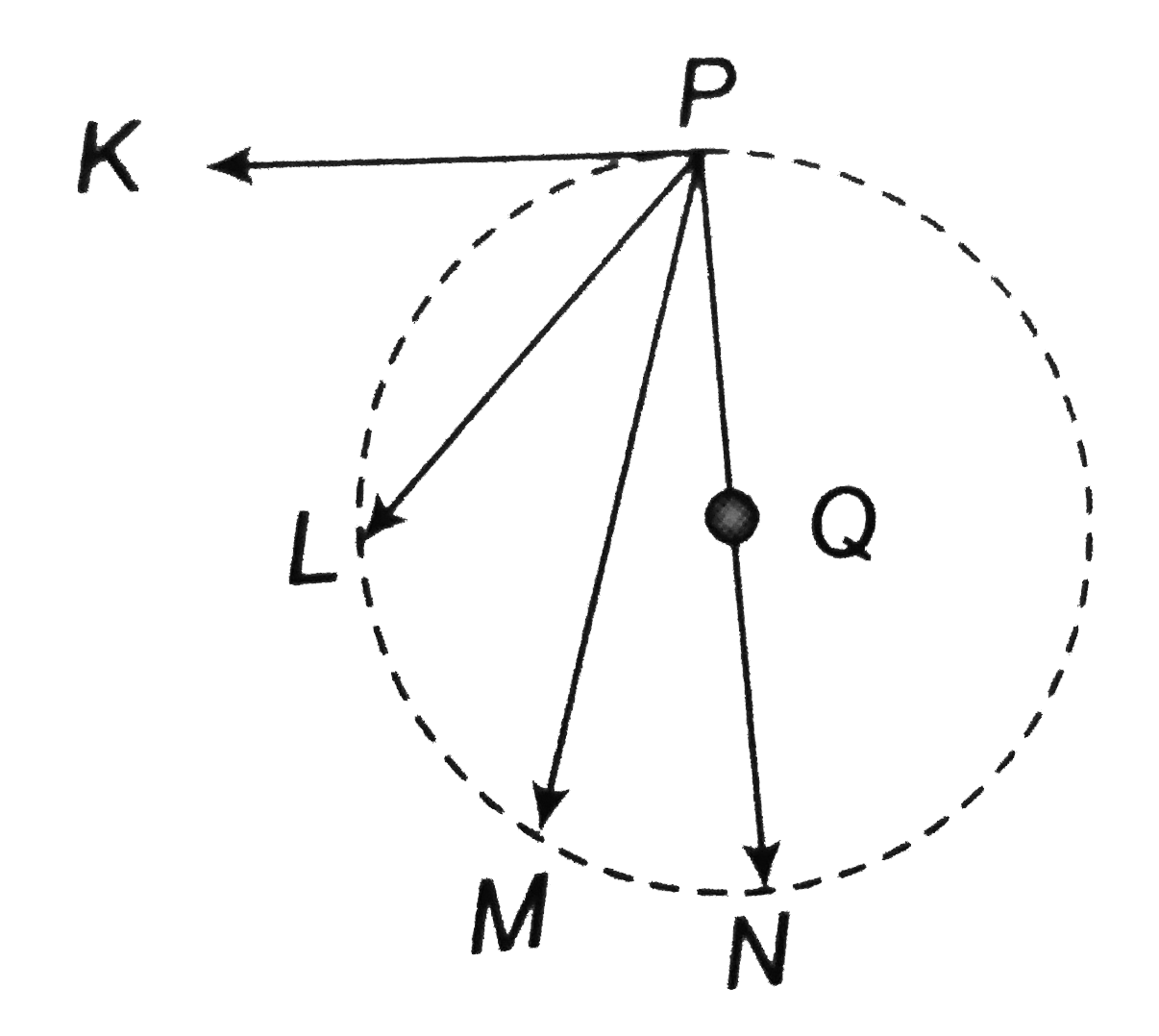 02:07View Solution
02:07View SolutionA mass `m=20 g` has a charge `q= 3.0 mC`. It moves with a velocity of 20 m/s and enters a region of electric field of 80 N/C in the same direction as the velocity of the mass. The velocity of the mass after 3 s in this region is
02:33View SolutionFour idenbtial charges `+50 mu C` each are placed, one at each corner of a square of side `2 m`. How much external energy is required to bring another charge of `+50 mu C` from infinity to the centre of the square
(Given `(1)/(4pi epsilon_(0)) = 9 xx 10^(9)(Nm^(2))/(C^(2)))`02:45View SolutionIn Millike's oil drop experiment an oil drop carrying a charge `Q` is held stationary by a potential difference `2400 V` between the plates. To keep a drop of half the radius stationary the potential difference had to be made `600 V`. What is the charge on the second drop ?
02:41View SolutionA charge of `5 C` experiences a force of `5000N` when it is kept in a uniform electric field. What is the potential difference between two points separted by a distance of `1 cm` ?
01:13View SolutionTwo insulated charged conducting spheres of radii `20 cm` and `15 cm` respectively and having an equal charge of `10 C` are connected by a copper wire and then they are separated. Then
02:32View SolutionEqual charges `q` are placed at the vertices `A` and `B` of an equilatral triangle `ABC` of side `a`. The magnitude of electric field at the point `C` is
03:39View SolutionTwo charges of equal magnitude q are placed in air at a distance 2a apart and third charge `-2q` is placed at mid-point . The potential energy of the system is `(epsi_(0)` = permittivity of free space)
05:46View SolutionTwo point charges `100 mu C` and `5 mu C` are placed at points `A and B` respectively with `AB = 40 cm`. The work done by external froce in displacing the charge `5 mu C` from B to C, where `BC = 30 cm`, angle `ABC = (pi)/(2)` and `(1)/(4pi epsilon_(0)) = 9 xx 10^(9)Nm^(2)//C^(2)`
03:31View SolutionThe unit of intensity of electric field is
01:39View SolutionEqual charges are given to two spheres of different radii. The potential will
01:40View SolutionA chrage of `5 C` is given a displacement of `0.5 m`. The work done in the process is `10 J`. The potetnial difference between the two points will be
01:13View SolutionThe electric potential `V` is givne as a function of distance `x` (metre) by `V = (5 x^(2) + 10x - 9)` volt. Value of electric field at `x = 1 `is
02:13View SolutionTwo metal pieces having a potential difference of `800V` are `0.02 m` apart horizontally. A particle of mass `1.96xx10^(-15) kg` is suspended in equilibrium between the plates. If the `e` is the elementary charge, then charge on the particle is
03:26View SolutionThe figure shows some of the electric field lines corresponding to an electric field. The figure suggests
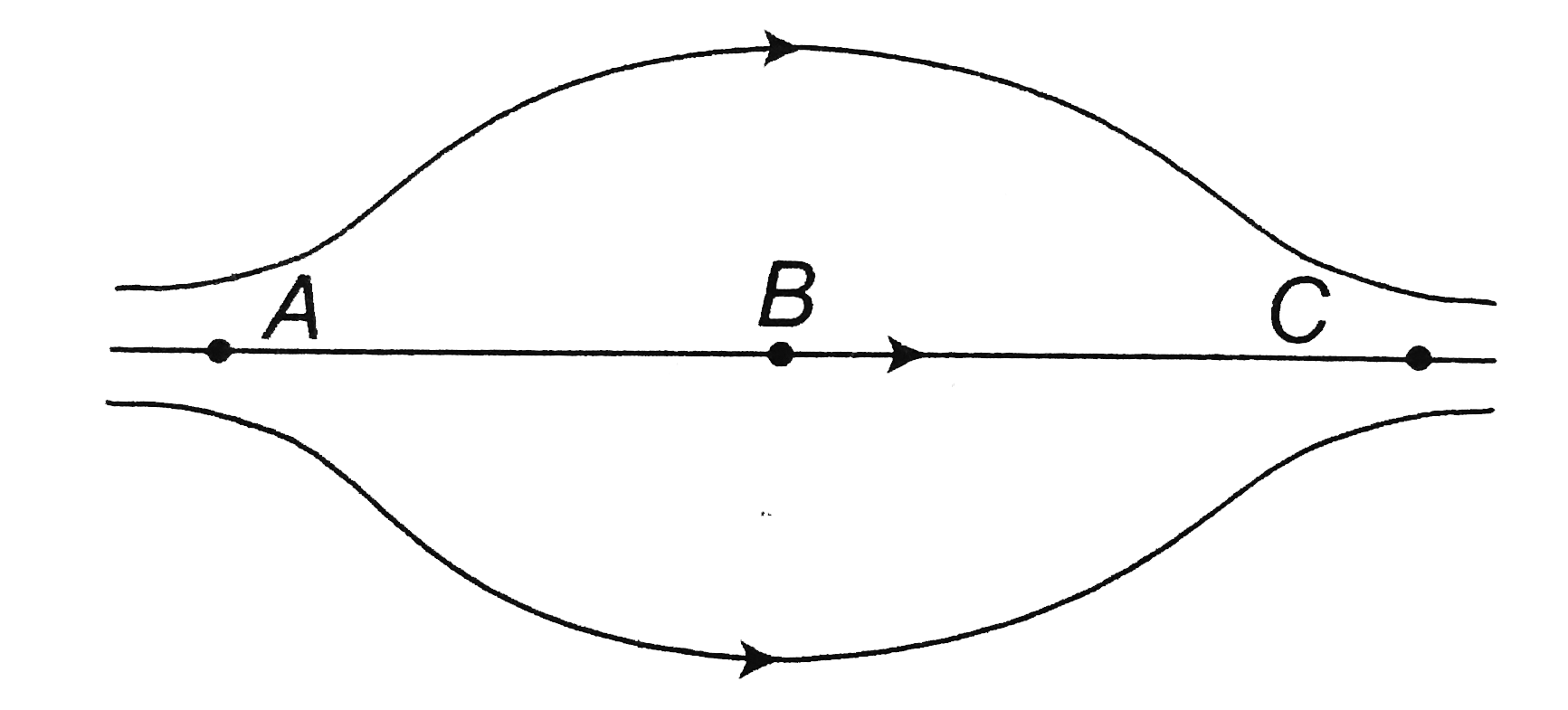 02:36View Solution
02:36View SolutionTwo spheres of radius `a` and `b` respectively are charged and joined by a wire. The ratio of electric field of the spheres is
01:19View SolutionA particle of mass m and charge q is placed at rest in a uniform electric field E and then released, the kinetic energy attained by the particle after moving a distance y will be
02:22View SolutionA hollow insulated conducting sphere is given a positive charge of `10 mu C` . What will be the electric field at the centre of the sphere it is radius is `2` metres ?
02:30View SolutionAn electron of mass `m_(e )` initially at rest moves through a certain distance in a uniform electric field in time `t_(1)`. A proton of mass `m_(p)` also initially at rest takes time `t_(2)` to move through an equal distance in this uniform electric field.Neglecting the effect of gravity, the ratio of `t_(2)//t_(1)` is nearly equal to
03:35View SolutionA cube of side b has a charge q at each of its vertices , Determine the potential and electric field due to this charge array at the centre of the cube.
06:07View SolutionA charged water drop whose radius is `0.1mum` is in equilibrium in an electric field. If charge on it is equal to charge of an electron, then intensity of electric field will be `(g=10ms^(-1))`
03:37View SolutionFour charge are placed at the corners of a square of side 10 cm as shown in figure having. If q is `1 mu C`, then what will be electric field intensity at the centre of the square?
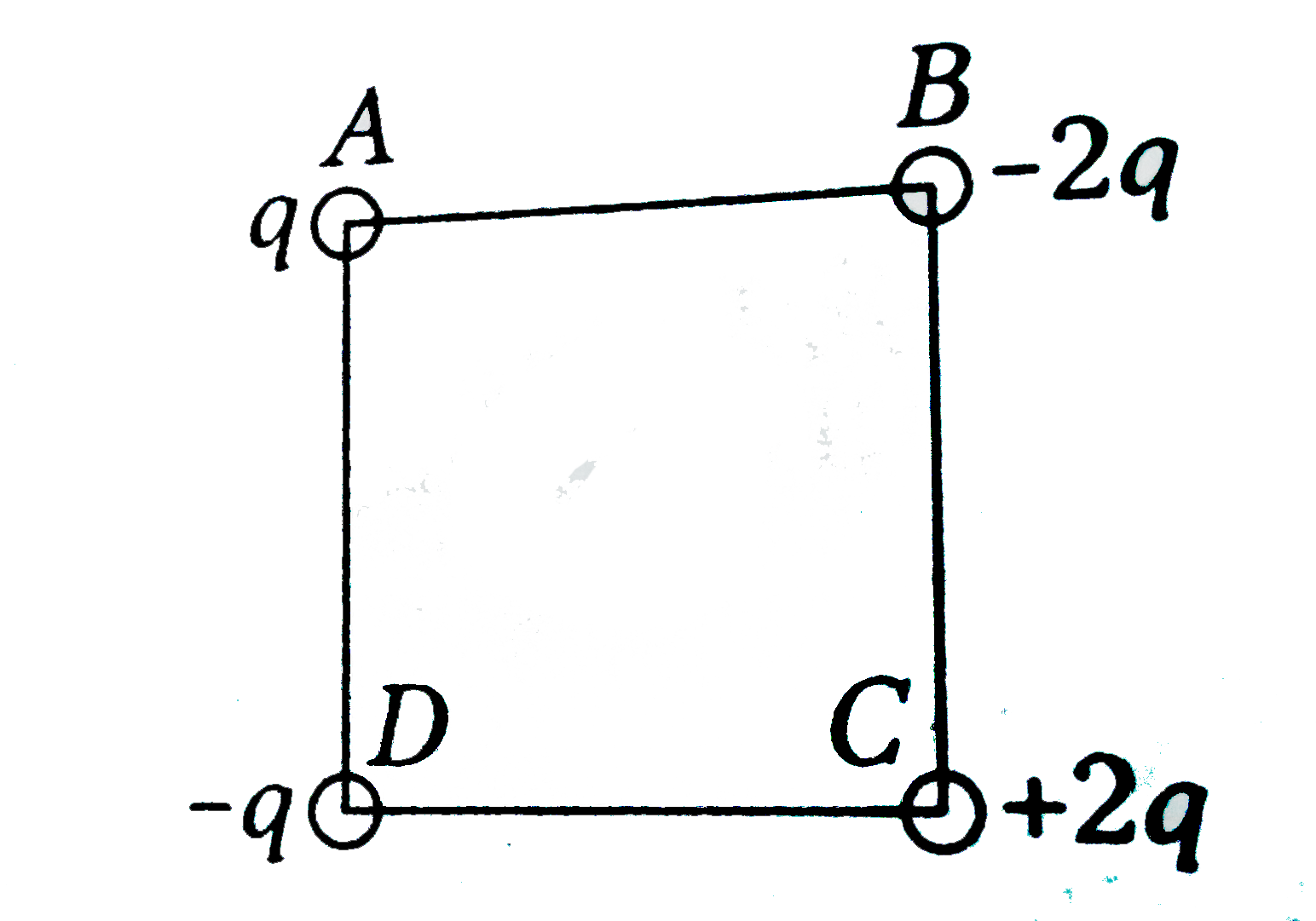 07:30View Solution
07:30View SolutionA sphere of radius `1 cm` has potential of `8000 V`, then energy density near its surface will be
01:48View SolutionPoint charges `+4q, -q` are kept on the `x`-axis at points `x=0,x=a` and `X=2a` respectively, then
08:46View SolutionTwo point charges of `20 mu C` and `80 muC` are 10 cm apart where will the electric field strength be zero on the line joining the charges from `20 mu C` charge
02:34View SolutionHow much kinetic energy will be gained by an `alpha-`particle in going from a point at `70 V` to another point at `50 V`
01:39View SolutionIf a charged spherical conductor of radius `10 cm` has potential `V` at a point distant `5 cm` from its centre, then the potential at a point distant `15 cm` from the centre will be
02:19View SolutionTwo unlike charges of magnitude `q` are separated by a distance `2d`. The potential at a point midway between them is
01:18View SolutionWhat is the potential energy of the equal positive point charges of `1 mu C` each held `1 m` apart in air ?
01:32View SolutionAn ail drop having charge `2e` is kept stationary between two parallel horizontal plates `2.0 cm` apart when a potential difference of `12000` volts is applied between them. If the density of oil is `900 kg//m^(3)`, the radius of the drop will be
02:38View SolutionThe ratio of moment of an electron and an `alpha`-particle which are accelerated from rest by a potential difference of `100V` is
01:55View SolutionA proton is accelerated through `50,000 V`. Its energy will increase by
02:05View SolutionWhen a proton is accelerated through `1 V`, then its kinetic energy will be
01:13View SolutionAn electron enters between two horizontal plates separated by `2 mm` and having a potential difference of `1000V`. The force on electron is
01:33View Solutiontwo metal spheres of radii `R_(1)` and `R_(2)` are charged to the same potential. The ratio of charges on the spheres is
01:31View SolutionElectric charges of `+10 muC,+5 muC,-3 muC and +8 muC` are placed at the corners of a square of side `sqrt(2)` m, the potential at the centre of the square is
04:28View SolutionThe electric field due to a charge at a distance of 3 m from it is `500 NC^(-1)`. The magnitude of the charge is
`[(1)/(4 pi epsi_(0)) = 9 xx 10^(9) N - m^(2)//C^(2)]`02:49View SolutionTwo charges of `4 mu C` each are placed at the corners `A` and `B` of an equilaternal triangle of side length `0.2 m` in air. The
electric potential at `C` is `[(1)/(4pi epsilon_(0)) = 9 xx 10^(9) (N-m^(2))/(C^(2))]`01:26View Solutionfind the electric field strength due to a point charge of `5 muC` at a distance of 80 cm from the charge.
02:30View SolutionTen electrons are qually spaced and fixed around a circle of radius `R`. Relative to `V = 0` at infinity, the electrostatic potential `V` and the electric field `E` at the centre `C` are
01:53View SolutionTwo positive point charges of `12 mu C` and `8 mu C` are `10 cm` apart. The work done in bringing then `4 cm` closer is
02:56View SolutionThree identical points charges, as shown are placed at the vertices of an isosceles right angled triangle. Which of the nembered vectors coincides in direction with the electric field at the mid-point `M` the hypotenuse
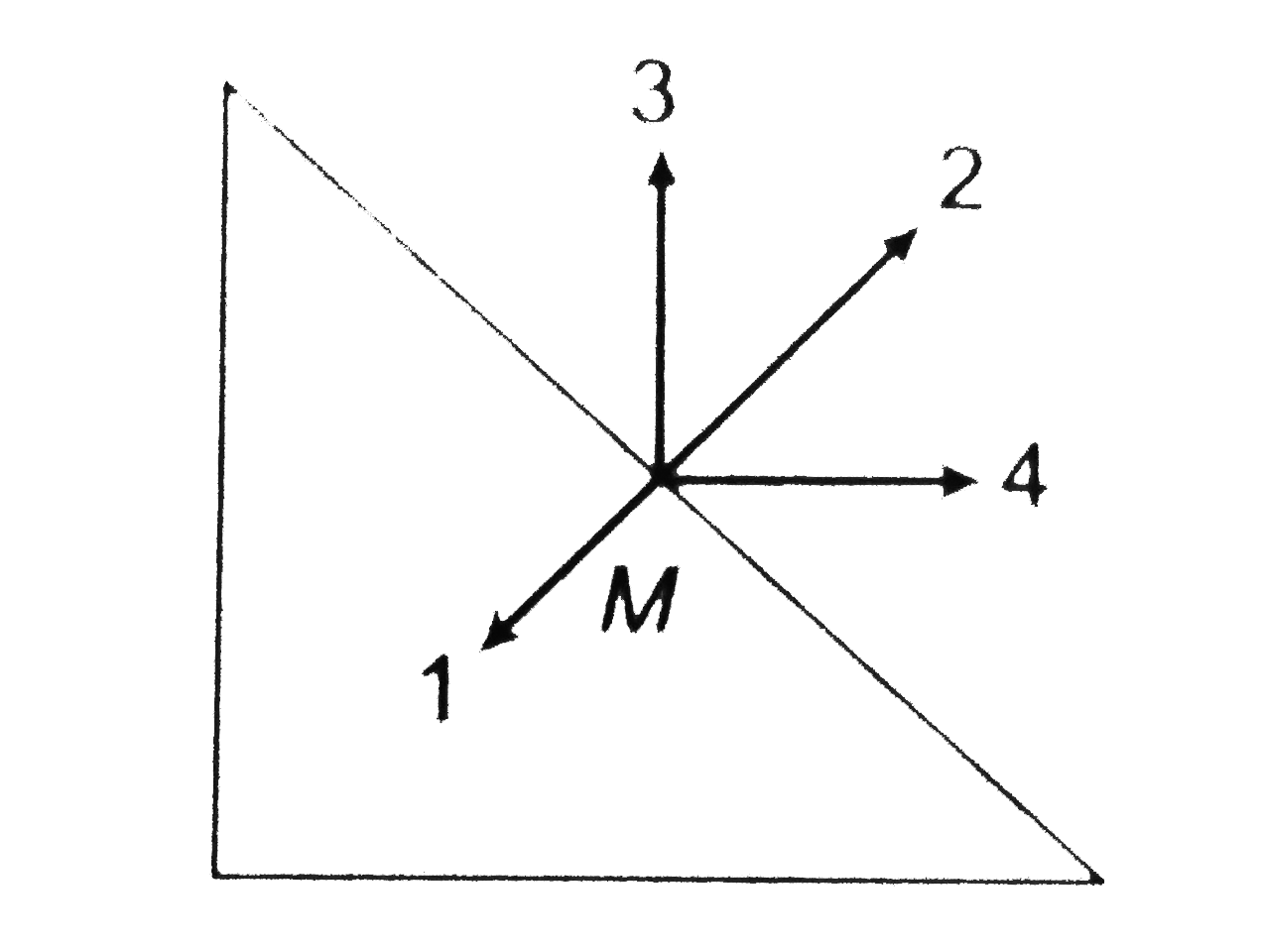 01:25View Solution
01:25View SolutionThe displacement of a chrage `Q` in the electric field
`E = e_(1)hati + e_(2)hatj + e_(3)hatk " is " vecr = ahati + bhatj`. The work done is02:14View SolutionThe potential at a point, due to a positive charge of `100 mu C` at a distance of `9 m`, is
01:28View SolutionA non-conducting solid sphere of radius R is uniformly charged. The magnitude of the electric filed due to the sphere at a distance r from its centre
04:20View SolutionTwo charges `+5mu C` and `+10 mu C` are placed `20 cm` apart. The net electric field at the mid-point between the two charges is
03:16View SolutionWhich of the following is deflected by electric field ?
02:36View SolutionAs shown in the figure, charges and are placed at the vertices and of an isosceles triangle. The potential at the vertex A is
 02:30View Solution
02:30View SolutionConsider the points lying on a straight line joining two fixed opposite charges. Between the charges there is
06:31View Solution
Ordinary Thinking Objective Questions (Electric Field and Potential) questions and complete solutions for chapter ELECTROSTATICS of UNIVERSAL BOOK DEPOT 1960 PHYSICS (HINGLISH) of Class 12
